A Perfect Prius It Is Not
Lexus likes to say that it pursues perfection. Toyota's luxury brand has been playing the hybrid game for a while now with converted gas-powered models like the LS, GS and RX hybrids, and few would argue that these models represent the zenith of what a luxury hybrid can be. For that, Lexus finally decided to build a dedicated hybrid model from the ground up, and the result is the HS 250h.
Being that the brand's parent company builds the Prius, the industry benchmark for hybrids in terms of both fuel efficiency and popularity, Lexus has, on the one hand, a much deeper well of hybrid expertise from which to draw than its competition. On the other hand, it has the toughest act to follow in the third-generation Prius. In the minds of many, a true Lexus hybrid should be everything Toyota's magic bean is and more – it should be the perfect Prius.
Funny thing, the HS 250h is not. Lexus hasn't built an upmarket version of the Prius with the HS 250h. Perhaps realizing that after three generations creating about as perfect a parallel hybrid as there is, Lexus up and decided that its own luxury hybrid should have a different mission. Unfortunately, after a week spent behind the wheel of a 2010 HS 250h Premium, we're not still not sure what that mission is. Follow the jump to learn what else we found confusing about Lexus' latest hybrid.
2010 Lexus HS 250h - Click above for high-res image gallery
Lexus likes to say that it pursues perfection. Toyota's luxury brand has been playing the hybrid game for a while now with converted gas-powered models like the LS, GS and RX hybrids, and few would argue that these models represent the zenith of what a luxury hybrid can be. For that, Lexus finally decided to build a dedicated hybrid model from the ground up, and the result is the HS 250h.
Being that the brand's parent company builds the Prius, the industry benchmark for hybrids in terms of both fuel efficiency and popularity, Lexus has, on the one hand, a much deeper well of hybrid expertise from which to draw than its competition. On the other hand, it has the toughest act to follow in the third-generation Prius. In the minds of many, a true Lexus hybrid should be everything Toyota's magic bean is and more – it should be the perfect Prius.
Funny thing, the HS 250h is not. Lexus hasn't built an upmarket version of the Prius with the HS 250h. Perhaps realizing that after three generations creating about as perfect a parallel hybrid as there is, Lexus up and decided that its own luxury hybrid should have a different mission. Unfortunately, after a week spent behind the wheel of a 2010 HS 250h Premium, we're not still not sure what that mission is. Follow the jump to learn what else we found confusing about Lexus' latest hybrid.
Photos copyright ©2010 Drew Phillips / AOL
As we said, the HS 250h is not a gussied-up Prius, and your first clue is that it looks nothing like the Toyota hybrid. The Prius was honed by computers to balance the maximum amount of interior space with the slipperiest shape possible, and the result is one of the most aerodynamic production cars in the world with a 0.25 coefficient of drag. The HS 250h achieves an also impressive but more modest 0.27 Cd thanks to its more conventional three-box shape. This tall sedan's design, however, looks a little disproportionate, like a Hot Wheels version of the larger LS.
Despite its size, the HS 250h still exudes an air of expensive sophistication from the outside. Though many people didn't recognize what we were driving, no one thought it was a Corolla. Credit goes to the rich paint color options, including the Matador Red Mica shade of the car we used to photograph, as well as the lustrous Aurora White Pearl of our actual tester. Likewise, nicely packaged lighting hardware that includes projector-beam headlamps (optional high-tech LED front lamps are available) and LED taillamps let passers by know you aren't rocking a Yaris. Then there are the wheels. Standard models receive 17-inch split five-spoke wheels while Premium models go even larger with complex-looking 18-inch split seven-spoke wheels.
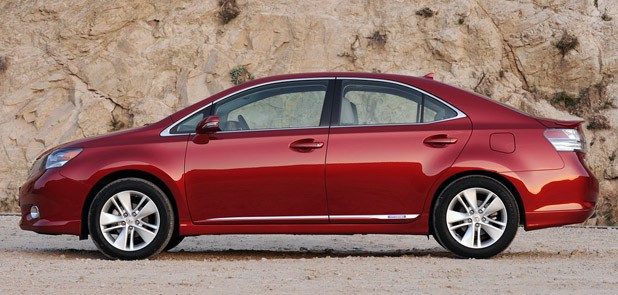
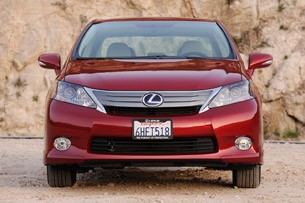
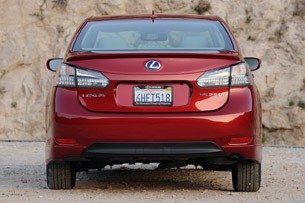
Just like the exterior, the interior immediately lets you know that you're not sitting in a Prius. The dash design is entirely different, with high-class electroluminescent gauges placed right behind the steering wheel where they should be. The center stack doesn't sweep out all the way to the center armrest as in the Prius, but stops halfway, leaving a crevice for cupholders and controls for the heated and cooled 10-way adjustable front seats. The seats themselves set a standard for comfort and are draped in the most buttery semi-aniline leather this side of a Bentley, and Lexus scores a point of green cred for using bioplastics to cover 30% of the interior and trunk.
There's a lot of tech to take in once situated, and the odd-looking controller at the bottom of the center dash just begs to be played with. Lexus calls its all-in-one controller Remote Touch, which is to say it remotely controls the flip-up nav screen mounted high on the dash. Your palm rests flat on the controller just like a computer mouse, and buttons for various controls are within comfortable reach of your fingers and thumb. The controller moves an arrow around the nav screen, but the real trick is its inclusion of haptic feedback, which means you actually feel through the controller when the arrow glides over a button on the screen.
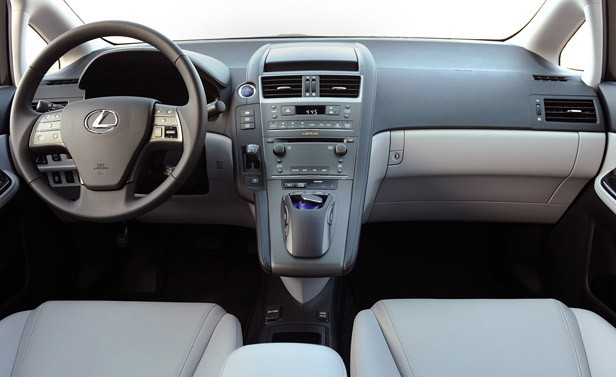
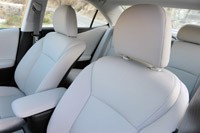
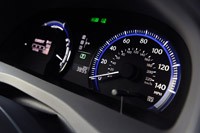
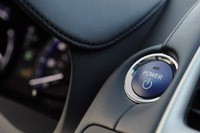
Lexus says its Remote Touch controller is safer than a traditional dash-mounted touch screen because the display is mounted higher, thereby requiring less eye movement to view. Being analogous to a computer screen and mouse, it's easy to learn and quickly be comfortable with, but such a complicated configuration doesn't feel any safer and surely isn't more intuitive to use than simply touching a screen.
Along with the innovative joystick, buyers can also load up the HS 250h with the very latest infotainment technology. The laundry list of top-shelf tech includes an optional 15-speaker Mark Levinson stereo; the latest XM satellite radio hardware beaming in programming as well as traffic, weather, sports and stock info; Bluetooth phone and audio integration; casual speech voice recognition; and the brand's own OnStar-like service called Lexus Enform with Safety Connect. A $3,900 Technology Package also adds a heads-up display that projects vehicle speed, audio info and turn-by-turn directions on the windshield; radar-based cruise control; park-assist sensors; a pre-collision warning system; and a new piece of tech called Lane Keep Assist, which we'll get to in a moment.
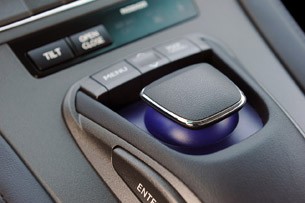
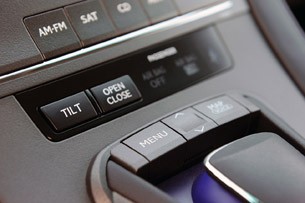
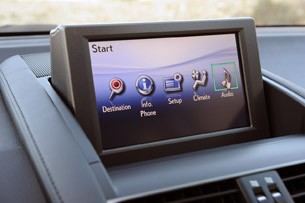
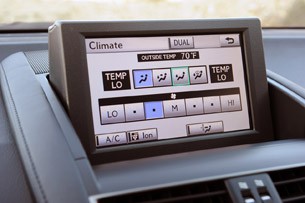
The HS 250h may have more technology packed in its interior than a DARPA lab, but demerits are surely deserved for the poor user experience when plugging in an iPod or iPhone via the USB port. Doing so allows you to charge the Apple device as well as navigate its contents using the Remote Touch controller and nav screen. Unfortunately, Lexus has less experience designing interfaces than Apple and it shows. It's easier to just connect your Apple hardware via Bluetooth and play DJ through the device itself. Of course, there are safety questions posed by taking your hands off the car's controls and looking at the Apple's small screen, and you lose the ability to charge your device. On one long trip, we were forced to switch and back forth between connecting via USB and Bluetooth because our iPhone was getting low on juice.
Not long after we discovered that the HS 250h is annoying to use with our iPhone did we stumble upon a gem of tech that made us smile again. It's called the Wide-View Front Monitor and is available as a $700 option. It works just like a backup camera, but it's in the front and can display up to 190 degrees of the world at front bumper level. It's particularly handy when pulling into parking spots or gently nosing out into an intersection when one's view of crossing traffic is otherwise blocked. Unlike the backup camera, the Wide-View Front Monitor can be set to come on any time the car is in Drive and moving forward under 7.5 miles per hour, or manually by pressing a button on the lower left part of the dash. We say leave it on manual, otherwise your nav screen will switch back and forth in stop-and-go traffic like a TV on the fritz.
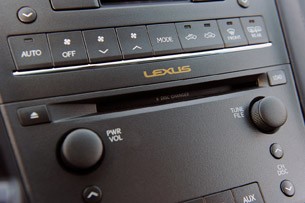
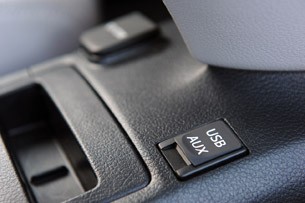
And when it comes to viewing the back bumpers of other vehicles, the HS 250h will be doing a lot of that. Its 2.4-liter Atkinson-cycle four-cylinder engine produces 147 horsepower at 6,000 rpm and 138 foot pounds of torque at 4,400 rpm. Being a parallel hybrid, it can also call in the electric cavalry from a 141-hp electric motor, though total combined power is limited to 187 hp, all of which makes its way to the front wheels through a continuously variable transmission. The Prius can only muster a combined total power output of 134 hp, so the Lexus should feel like an electric hot rod, right? Nope. An extra 640-728 pounds (depending on trim level) of earth-crushing weight is carried around by the HS 250h. There's a reason some people call rich people fat cats, and the same goes for their vehicles, apparently.
That said, the HS 250h will outrace a Prius to 60 miles per hour, 8.4 seconds to 9.8 seconds. It also offers four modes of powertrain pleasure: Normal, Power, Eco and EV. We're assuming Lexus recorded its Prius-beating 0-60 mph time using Power mode, which makes the HS 250h feel only as lively and responsive as a very heavy Corolla. Power mode should instead be called Normal because that's what it best approximates, and Normal and Eco mode should be called Eco and Numb. In actual Eco mode, the throttle behaves like a body part pumped full of Novocain. It's all in the name of increasing MPGs, but firmly pressing the gas pedal and getting back disproportionately less power is a disconcerting sensation that, for the most part, left Eco mode off the table for us.
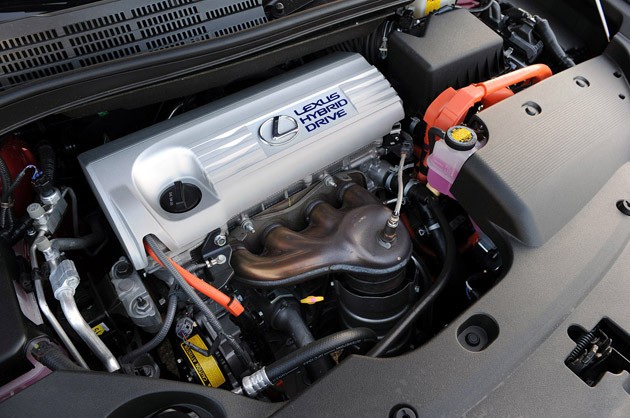
Finally there's EV mode, which as its name suggests allows the vehicle to be driven solely on electricity for short distances. In our experience, "short distances" meant from one driveway to the next... while coasting. Nearly any application of the throttle will pop the car out of EV mode. The Ford Fusion Hybrid (and now the Lincoln MKZ Hybrid, which will directly compete with the HS 250h) allows pure EV travel up to 47 mph, which is actually useful and more importantly, repeatable, at least until the battery pack screams "Uncle!" By comparison, EV mode in the HS 250h is a novelty you'll probably never use in the real world.
You'll eventually want to stop and the HS 250h has brakes that are poles apart from the rest of the car's laissez-faire attitude. Whereas the deadened accelerator requires your foot to play the part of defibrillator paddle, the brakes are fully awake and sensitive to the slightest touch. They're regenerative, which means in addition to arresting motion, they're also charged (ha!) with converting the car's motion into extra energy for the battery pack. The coordination of these two duties is handled by the electronic controlled brake (ECB) computer, the calibration of which is likely why the HS 250h's brakes feel anxious underfoot. The regen comes on too soon and too strong, hauling the car down faster than you intend. When combine that with the opposite nature of the throttle, your right foot feels schizophrenic as you try to keep straight which pedal gets the firm push and which the light touch.
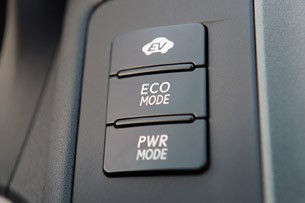
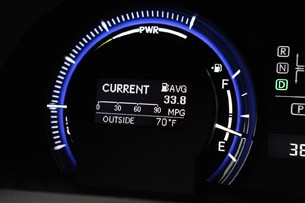
We did discover an area in which the HS 250h excelled on the road, and that's highway cruising. The HS 250h is one of the most effortless cars we've encountered in a straight line. That may sound like a simple task, but a good, long road trip can be exhausting in vehicles with twitchy steering, a bumpy ride and uncomfortable seats. The HS 250h has seats made for comfort, not corners, and the MacPherson strut front suspension and double wishbone rear are ideally suited to soak up expansion joints. The steering, however, is particularly ideal for long distance drives. Toyota has continually evolved its electric power steering, and the system in the HS 250h, while never managing to accurately mimic actual feedback from the road, always seems to offer the right amount of resistance no matter the speed.
Particularly impressive is Lexus' new Lane Keep Assist technology. It works with the Lane Departure Warning system and Dynamic Radar Cruise Control to actually see the lane markers flying by on either side of the car and increases the amount of effort required to turn the wheel so it's easier to keep the HS 250h on a straight and narrow path. This also helps counter cross winds that try to upset the rather tall sedan's composure on the highway.
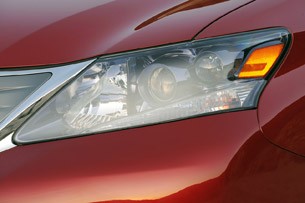
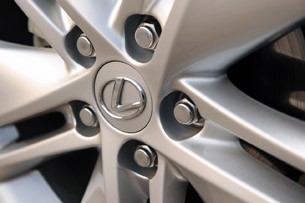
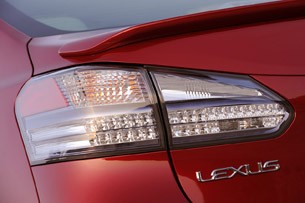
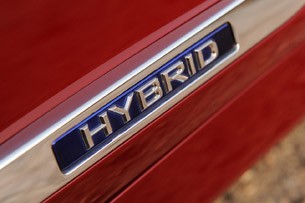
So in terms of ride and comfort, the HS 250h meets the bar set by larger luxury vehicles. But this is where this hybrid's mission gets muddled. The base price of the HS 250h is $34,650. Our particular tester was the Premium trim, which starts at $36,970 and also included the aforementioned Mark Levinson stereo ($1,580), navigation system ($2,125) and Technology Package ($3,900). The sticker price was also padded with $397 worth of floor mats. For those without a TI-82 handy, that's a grand total of $45,672, not including a destination and delivery charge of $875.
Lexus doesn't want us comparing the HS 250h to the Prius, but we can't help it. The Prius starts at $22,800 and if you're hell bent on giving Toyota your money, can be optioned up to nearly $35,000. Fully loaded, the two are about $10,000 apart in price, so the average consumer might expect a commensurate amount of increased mpg for the premium commanded by the HS 250h. Not quite. How about fuel efficiency equal to that of the Prius? Not even close. The Prius leads the league with an official EPA rating of 51 mpg city, 48 highway and 50 combined. The HS 250h manages a score of 35 mpg city, 34 highway and 35 combined. That's about a 15 mpg deficit on top of asking $10,000 more for a car that some had hoped would be the perfect Prius.
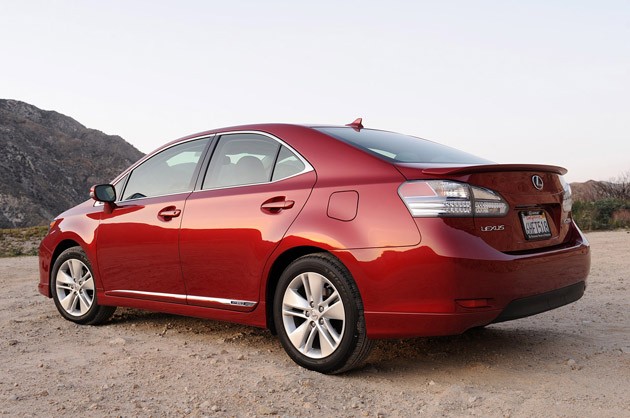
But again, that's not the mission of the Lexus HS 250h. Best we can tell, this car is for the loyal Lexus buyer who wouldn't be caught dead in a Toyota but still wants that oh-so-fresh feeling of driving a hybrid, regardless of how well it actually performs in that regard. Unfortunately, Lexus has gone too far trying to differentiate the HS 250h, and in the process, it has spoiled the one trait that makes the Prius such a hot seller: MPGs. Perhaps the brand that claims to pursue perfection should have developed its own version of the perfect Prius, one that justifies such a high price tag with bragging rights for being more fuel efficient than its common cousin, not less.
Photos copyright ©2010 Drew Phillips / AOL
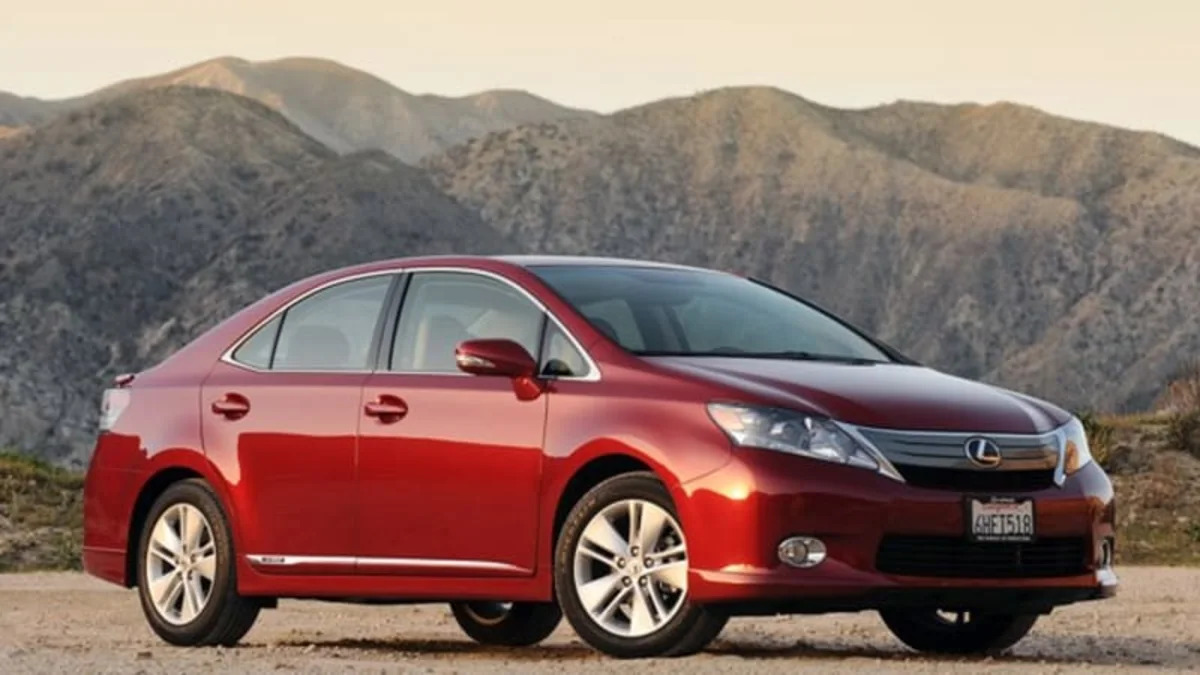
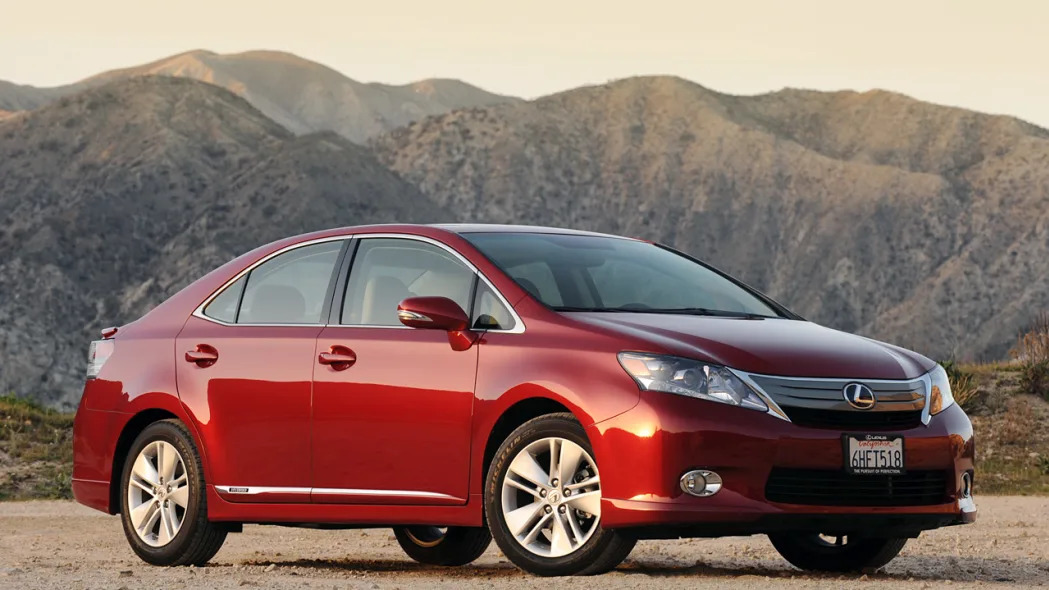

Sign in to post
Please sign in to leave a comment.
Continue